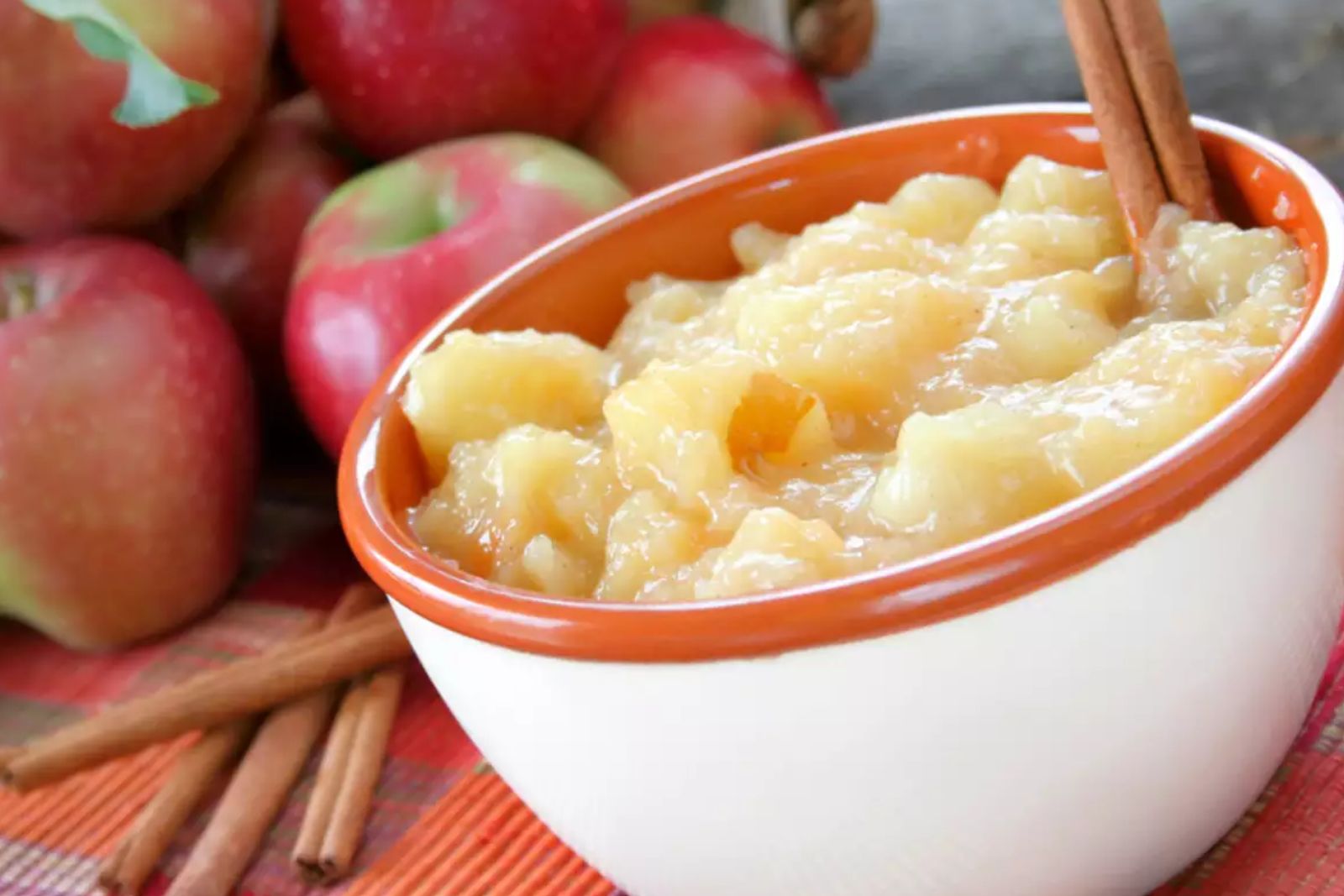
Stewed apples are a delightful treat, bursting with flavor and warmth. Whether you’ve prepared a large batch or have some leftover stewed apples, freezing them can be a great way to preserve their deliciousness for later use. Freezing stewed apples ensures that you can enjoy this comforting treat even when apples are not in season. With a few simple steps, you can freeze stewed apples while maintaining their texture and taste. This article will guide you through the process of freezing stewed apples to keep them fresh and ready for future enjoyment.
Here’s a step-by-step guide on how to freeze stewed apples:
Step 1: Let the stewed apples cool
After you’ve prepared your delicious batch of stewed apples, it’s essential to let them cool completely before moving on to the freezing process. Allowing the stewed apples to cool serves two critical purposes in ensuring the quality of the frozen product.
- Texture preservation: Cooling the stewed apples helps maintain their desired texture. When hot food is immediately placed in the freezer, it can lead to the formation of ice crystals within the food. These ice crystals can cause the cells of the apples to rupture, resulting in a mushy and undesirable texture once thawed. By letting the stewed apples cool naturally, you give them time to settle and avoid potential textural degradation during the freezing process.
- Condensation prevention: When hot or warm food is placed in a container and sealed for freezing, it can create condensation inside the container. This happens because the warm air trapped inside the container cools down, and its moisture turns into water droplets. This condensation can lead to freezer burn, a condition where frozen food becomes dehydrated and develops unpleasant dry, white patches on the surface. Freezer burn affects both the taste and texture of the food and can lead to food waste. Allowing the stewed apples to cool completely before freezing reduces the chances of condensation forming inside the containers and helps maintain the quality of the frozen product.
To cool the stewed apples, simply transfer them to a wide, shallow container or a heatproof bowl. This allows for faster cooling as it increases the surface area of the stewed apples exposed to the air. Avoid placing hot stewed apples in a deep, closed container as it may take longer for them to cool down, and condensation might occur inside the container.
Once the stewed apples have cooled to room temperature, you can proceed with portioning them into freezer-safe containers or bags. Remember to leave some space at the top of the containers or bags to allow for expansion during freezing. For optimal results, use airtight containers or containers specifically designed for freezing to keep the stewed apples fresh and free from unwanted odors.
Step 2: Choose the right containers
Selecting the appropriate containers for freezing your stewed apples is crucial to maintaining their quality and preventing freezer-related issues. When it comes to freezing food, especially items with liquids like stewed apples, it’s essential to use containers that are specifically designed for freezing purposes. Here’s why it matters:
- Freezer-safe materials: Freezer-safe containers are made from materials that can withstand low temperatures without cracking or becoming brittle. Airtight plastic containers and heavy-duty freezer bags are two common options for freezing stewed apples. These materials are designed to hold up well in freezing temperatures, ensuring that the containers won’t degrade, leak, or allow freezer odors to seep in.
- Preventing freezer burn: Freezer burn occurs when food is exposed to air inside the freezer, causing moisture loss and oxidation. It can negatively impact the taste and texture of the stewed apples. Airtight containers, especially those with secure lids, minimize the contact of the apples with air, reducing the chances of freezer burn and helping to preserve their freshness.
- Easy storage and organization: Choosing containers of uniform size and shape makes it easier to stack and organize them in the freezer. This ensures efficient use of freezer space and allows you to access the stewed apples without disrupting other frozen items.
- Leakage prevention: Stewed apples contain liquid, and improper containers may lead to leaks during freezing. Airtight plastic containers with secure lids or heavy-duty freezer bags with reliable seals minimize the risk of leakage, keeping your freezer clean and tidy.
- Easy portioning: Opting for smaller-sized containers or freezer bags allows you to freeze stewed apples in portions that suit your needs. This way, you can thaw only what you intend to use, preventing unnecessary waste.
Before filling the containers, ensure they are clean and dry. Any residual food particles or moisture left in the containers can lead to freezer odors and affect the taste of the stewed apples. Wash the containers with warm, soapy water, and rinse them thoroughly. Allow them to air dry completely before adding the cooled stewed apples.
If you choose to use plastic containers, look for those labeled as “freezer-safe” to ensure they are suitable for long-term freezing. For freezer bags, heavy-duty options are more durable and less prone to tearing.
Step 3: Portion the stewed apples and fill the containers
Dividing the stewed apples into smaller portions before freezing is a practical and necessary step to ensure convenience and avoid wastage. Here’s why it’s essential to portion the stewed apples and leave space for expansion during freezing:
- Convenient serving sizes: Portioning the stewed apples allows you to freeze them in smaller, individual or family-sized servings. This way, you can thaw only the amount you need for a particular meal or recipe, without having to defrost the entire batch. It saves time and makes it easy to incorporate the stewed apples into various dishes without thawing more than necessary.
- Easy thawing: Smaller portions of stewed apples thaw faster than larger containers. When you freeze the stewed apples in smaller portions, they defrost more evenly and quickly, allowing you to enjoy their deliciousness without long waiting times.
- Minimize food waste: Portioning helps prevent unnecessary food waste. If you were to freeze the entire batch in one large container, you might end up thawing more than you can consume or use in a recipe, leading to potential wastage.
- Preserve flavor and texture: When you freeze the stewed apples in smaller portions, you reduce the number of times the container is opened and exposed to air. Each time you open the container, some air enters, increasing the risk of freezer burn. By portioning the apples, you can keep the remaining stewed apples in their original, undisturbed state, preserving their flavor and texture better.
When filling the containers, leave some space at the top to allow for expansion during freezing. Liquids, including the syrupy sauce from the stewed apples, expand as they freeze. If the container is filled to the brim, the expansion could cause the container to crack or break, ruining the stewed apples and potentially making a mess in your freezer.
For plastic containers with lids, leave about half an inch of space at the top. For freezer bags, gently press on the bag to remove excess air before sealing it shut. Removing excess air from freezer bags helps prevent the formation of ice crystals on the surface of the stewed apples, which can negatively affect their texture and flavor.
Can I use glass containers for freezing stewed apples?
While glass containers can be used for freezing stewed apples, exercise caution to prevent breakage due to expansion during freezing. Use freezer-safe glass containers, leave enough headspace, and avoid drastic temperature changes to reduce the risk of breakage.
Are there any alternatives to plastic containers and freezer bags for freezing stewed apples?
Yes, you can consider using silicone freezer containers or reusable silicone bags as eco-friendly alternatives. These options are also airtight and freezer-safe, ensuring your stewed apples remain fresh and delicious during freezing.
Step 4: Label the containers
Labeling the containers that hold your frozen stewed apples is a crucial step in maintaining organization and ensuring the best quality for future consumption. Here’s why labeling is essential:
- Date of freezing: Writing the date of freezing on each container allows you to keep track of how long the stewed apples have been in the freezer. Frozen foods, including stewed apples, are best consumed within a specific time frame to maintain their optimal taste and texture. By having the freezing date clearly labeled, you can easily identify how long the stewed apples have been frozen and prioritize using them based on their freshness.
- Rotation and consumption: Labeling the containers helps implement a “first in, first out” (FIFO) approach when using frozen stewed apples. It means that you should use the oldest containers first to ensure that nothing sits in the freezer for an extended period, risking diminished quality. By knowing the freezing dates, you can plan your meals accordingly, utilizing the older portions before moving on to the newer ones.
- Preventing confusion: Stewed apples might not look significantly different from other frozen foods, especially when stored in identical containers. By adding a brief description of the contents, you eliminate any confusion that may arise when trying to identify the stewed apples among other frozen items. It saves you from accidentally thawing the wrong food or having to open multiple containers to find what you’re looking for.
- Time-sensitive consumption: Certain recipes or occasions might call for using stewed apples from a specific date range. For instance, if you’re preparing a special dessert for a family gathering, you might prefer using the freshest batch of stewed apples. Having clear labels helps you make informed choices when selecting the appropriate portions for different purposes.
To label the containers, use a marker or adhesive labels that adhere well to freezer containers. Write the date of freezing in a clear and visible manner. You can use a “mm/dd/yyyy” format for consistency and easy understanding.
Additionally, include a brief description of the contents, such as “Stewed Apples – Cinnamon & Sugar” or “Stewed Apples – McIntosh Apples.” This description will help you distinguish the stewed apples from other frozen items and remind you of any specific flavorings or apple varieties used in the preparation.
Remember to place the labels on the front or top of the containers for easy visibility. If you’re using freezer bags, you can write the information directly on the bag.
Step 5: Seal and store
Sealing the containers tightly is a critical step in the freezing process to maintain the quality and freshness of your stewed apples. Proper sealing prevents air from entering the containers, which can lead to freezer burn and negatively impact the taste and texture of the stewed apples. Here’s why sealing and storing the containers correctly is essential:
- Preventing freezer burn: Freezer burn occurs when frozen food is exposed to air, causing moisture to evaporate and ice crystals to form on the surface. If stewed apples are not adequately sealed, the air inside the container can lead to freezer burn, leaving the apples with dry, discolored patches and an altered taste. Ensuring a tight seal minimizes the chances of freezer burn and helps preserve the apples’ natural flavor and texture.
- Avoiding cross-contamination: A tight seal on the containers prevents any aromas or flavors from escaping or entering the stewed apples. This is especially important if you have other strongly flavored items stored in the freezer. A secure seal ensures that your stewed apples maintain their distinct taste and are not affected by neighboring frozen foods.
- Keeping the freezer organized: Properly sealed containers reduce the risk of spills and leaks, keeping your freezer neat and organized. Storing the containers on a flat surface ensures they freeze evenly and minimizes the risk of tipping over, which could cause unnecessary mess and make it challenging to retrieve items from the freezer.
To seal the containers, follow these steps:
For airtight plastic containers:
- Place the lid on the container and ensure it fits securely.
- Press down firmly on the lid to create a tight seal.
- Double-check that all edges are sealed to prevent any gaps where air can enter.
For freezer bags:
- Squeeze out as much air as possible from the bag before sealing it shut. You can do this by gently pressing the bag from the bottom up, pushing the air towards the opening.
- Once the excess air is removed, press the bag’s seal to close it tightly.
After sealing the containers or bags, place them on a flat surface in the freezer. Placing them flat ensures that the stewed apples freeze evenly and solidly. This also helps to prevent any accidental spills or leaks that might occur if the containers were tilted or placed on their sides.
For added organization, you can stack similar-sized containers on top of each other once they are fully frozen. This helps maximize freezer space and keeps everything neat and accessible.
Step 6: Freeze the stewed apples
Freezing the stewed apples is the final step in the preservation process, and it is crucial to ensure they stay fresh and flavorful until you’re ready to use them. Freezing slows down the natural enzymatic reactions that cause food to spoil, effectively preserving the taste, texture, and nutrients of the stewed apples. Here’s why freezing is essential and how to store frozen stewed apples properly:
- Preserving taste and texture: Freezing stewed apples locks in their flavor and maintains their tender texture. The low temperatures prevent bacteria and other microorganisms from growing, keeping the apples in their optimal state until you thaw and enjoy them. Properly frozen stewed apples will taste just as delicious and have the same delightful texture as when they were freshly made.
- Storage duration: The recommended storage duration for frozen stewed apples is typically 8 to 10 months for the best quality. During this time, the apples should retain their taste and texture. While the stewed apples may remain safe to eat beyond this period, the quality might start to decline gradually. The flavors may not be as vibrant, and the texture may become slightly mushy over time. To ensure the best taste and texture, it’s best to consume the frozen stewed apples within the recommended time frame.
- Freezer temperature: The freezing time for the stewed apples depends on your freezer’s temperature setting. Generally, it may take a few hours overnight for the stewed apples to freeze completely. To speed up the freezing process, ensure that your freezer maintains a temperature of 0 degrees Fahrenheit (-18 degrees Celsius) or below. Keeping the freezer at the right temperature ensures the stewed apples freeze quickly and uniformly, preserving their quality.
- Proper storage: Once the stewed apples are frozen, make sure to keep them in a part of the freezer where the temperature remains consistent. Fluctuating temperatures can cause the apples to thaw and refreeze, which may lead to a decline in quality. Avoid placing the stewed apples near the freezer door or in an area where they may be exposed to temperature changes.
To thaw the frozen stewed apples, remove the desired portion from the freezer and place it in the refrigerator overnight. Slow thawing in the refrigerator helps retain the texture and flavor better than rapid thawing at room temperature or in the microwave. Once thawed, you can use the stewed apples in your favorite recipes or enjoy them on their own as a delicious dessert.
Other related questions
Can I refreeze stewed apples?
Once stewed apples have been thawed, it is not recommended to refreeze them. Refreezing can lead to changes in texture, taste, and quality, as well as potential safety concerns. It is best to use thawed stewed apples within a short period or ensure proper portioning before freezing to avoid the need for refreezing.
How do I know if the stewed apples have gone bad after being frozen?
To determine if frozen stewed apples have gone bad, inspect them for any signs of spoilage, such as an off odor, mold growth, or unusual discoloration. If the texture appears excessively mushy or grainy, this could also indicate spoilage. Additionally, a sour or rancid taste may suggest that the stewed apples have deteriorated and should be discarded for safety reasons.
Can I freeze stewed apples without sugar or spices?
Yes, you can freeze stewed apples without sugar or spices if you prefer a more natural taste. Simply stew the apples with a little water or apple juice to prevent them from sticking to the pot and proceed with the freezing process as usual.
Can I freeze stewed apples with added spices like cinnamon and nutmeg?
Yes, you can freeze stewed apples with added spices like cinnamon and nutmeg. The spices enhance the flavor and aroma of the stewed apples, and they will retain their delightful taste even after freezing.
Can I freeze stewed apples made with different apple varieties together?
Yes, you can freeze stewed apples made with different apple varieties together. Mixing apple varieties can add complexity to the flavor of the stewed apples. Portion and freeze them as usual, and enjoy the unique blend of apple flavors when you use them in your recipes.








